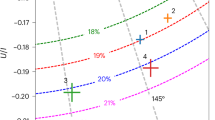Abstract
DURING observations of the polarization of the impulsive emission from the source CP 0950 a further feature of the profile reported previously1,2 has become apparent. Using the integration technique described earlier3, observations suggested the presence of impulsive emission in the region between the main pulses. Fig. 1 is a mean profile obtained at 408 MHz using the Mark I telescope. The newly discovered “interpulse” is evident and lies 100 ms before the peak of the main pulse. Subsequent measurements have demonstrated that this interpulse is very highly polarized.
Similar content being viewed by others
References
Lyne, A. G., and Rickett, B. J., Nature, 218, 326 (1968).
Lyne, A. G., and Smith, F. G., Nature, 218, 124 (1968).
Davies, J. G., Horton, P. W., Lyne, A. G., Rickett, B. J., and Smith, F. G., Nature, 217, 910 (1968).
Saslaw, W. C., Faulkner, J., and Strittmatter, P. A., Nature, 217, 1222 (1968).
Ostriker, J. P., Nature, 217, 1227 (1968).
Gold, T., Nature, 218, 731 (1968).
Author information
Authors and Affiliations
Rights and permissions
About this article
Cite this article
RICKETT, B., LYNE, A. Further Impulsive Emission from CP 0950. Nature 218, 934–935 (1968). https://doi.org/10.1038/218934a0
Received:
Issue Date:
DOI: https://doi.org/10.1038/218934a0
- Springer Nature Limited
This article is cited by
-
Some features of the pulsed radiation from the pulsar 1919+21 at 16.7, 20 and 25 MHz
Astrophysics and Space Science (1977)
-
Decametric radio emission from four pulsars
Nature (1976)
-
The secular variation of pulsar magnetic dipole moments
Astrophysics and Space Science (1976)
-
Wide Integrated Pulse Profiles of Pulsars
Nature Physical Science (1973)
-
Search for High Energy Gamma Rays from Four Pulsars
Nature (1970)





